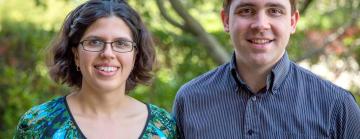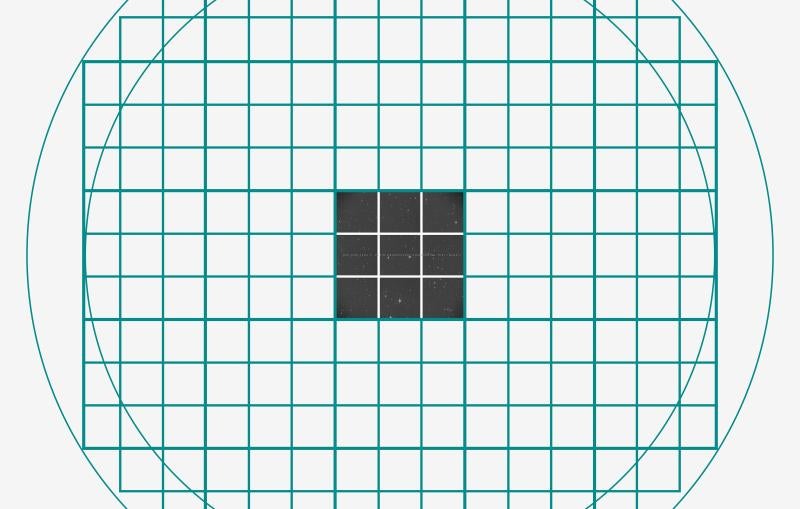SLAC physicists Natalia Toro and Philip Schuster win DOE's prestigious E.O. Lawrence Awards
Toro and Schuster are being recognized for their contributions to the design of experiments that use particle accelerators to search for dark matter particles.
Physicists Philip Schuster and Natalia Toro, professors at the Department of Energy's SLAC National Accelerator Laboratory, will receive DOE's Ernest Orlando Lawrence Award for their work developing new experimental searches for dark matter.
The DOE cited Schuster and Toro's work on the idea of using particle accelerators to search for light dark matter particles, which have masses roughly less than the mass of the proton. For one proposed project, the Light Dark Matter Experiment (LDMX), the pair and their colleagues have proposed using spare electrons from SLAC's LCLS-II accelerator and a dormant experimental station to produce dark matter in the lab.
This year, Schuster and Toro join eight other Lawrence Award winners representing 14 institutions in winning the Lawrence Awards. The awards recognize mid-career U.S. scientists and engineers working in a variety of fields, including biological and environmental sciences, energy, computer science and high energy physics, among others. Recipients will receive a medal and a $20,000 honorarium and will be honored at a virtual ceremony broadcast from Washington, D.C., in September.
"I am thrilled to recognize these researchers and the significant advances they have contributed to society. Scientists like these individuals are the backbone of DOE and we cannot achieve our mission without them. I’m excited to see what the future holds for them and where they may lead us,” said Asmeret Asefaw Berhe, Director of the DOE Office of Science.
Toro and Schuster said they both missed calls informing them of the awards: Toro was working from home and Schuster was on his way home from SLAC when Energy Secretary Jennifer Granholm made the calls. Toro said she discovered she'd won only after she checked her email and found a notification that Granholm had left a message.
"I was trying to figure out if I was sad that I'd missed this phone call that I would have been very happy to receive, or happy that I have this wonderful voice message preserved now for all time," Toro said.
Schuster said he was "genuinely surprised" and that he hopes the awards bring greater attention to new efforts in smaller-scale dark matter experiments at accelerators and more broadly. "It's a worldwide effort that's been underway for 15 years," Schuster said. "To the extent this award casts light on the progress that's been made, that's great.”
SLAC Lab Director Chi-Chang Kao said, “Natalia and Philip have developed innovative new approaches to searching for dark matter that leverage SLAC's capabilities and expand the horizons of what we can do. It’s exciting to think about what we might discover.”
The dark matter conundrum
Researchers hunting for dark matter have generally not had a lot to go on, Schuster said – mostly, how much of it there is, he said – although there are a number of possibilities. Today, the most popular candidates are all in a category known as weakly interacting massive particles, or WIMPs.
Some WIMP theories are motivated by an extension to the Standard Model of particle physics known as supersymmetry. According to that model, WIMPs should have a mass greater than – perhaps much greater than – one gigaelectron volt (GeV), roughly equivalent to the mass of the proton. And, Toro said, that territory is being explored by several well-established experiments, such as direct detection efforts that look for signs of dark matter collisions with liquid xenon or astrophysical searches for particles created in dark matter collisions or decays.
But, Toro said, "if you go below a few GeV, it's kind of terra incognita," with relatively few experiments exploring possibilities in that range.
There are, however, good reasons to probe that ground. One simple possibility is what's called a thermal relic. Early in the history of the universe, the hypothesis goes, the universe was hot enough that it could produce all manner of particles, including dark matter. Then, Toro explained, some of that dark matter would stick around as the universe cooled, leaving us with the dark matter we've observed today. Exactly how much should stick around depends on how heavy the dark matter particles are and how strongly they interact with ordinary matter, which defines a threshold that experiments should try to reach, Toro said.
An old idea comes back around
Whether it's a thermal relic or not, detecting light dark matter takes a different approach than most of what's been proposed previously. In fact, it could take a return to somewhat older ideas from the heyday of nuclear and elementary particle physics, when physicists used accelerators like SLAC's original linac to fire beams of electrons at fixed targets to probe the mysteries of quarks and other then-exotic particles.
That's more or less what the LDMX proposal is, Schuster said, albeit with some significant upgrades. In one possible scenario, the experimental setup would divert excess electrons from the accelerator driving SLAC's LCLS-II X-ray laser into the old End Station A, where they would strike a plate comprising heavy atoms such as tungsten. Those collisions would change the energy and direction of the electrons and produce photons – and perhaps produce dark matter. If so, researchers could search for signs of "missing momentum," or anomalies in the energy and direction of the electrons and photons that emerge following a collision.
The trick is that it isn't enough to look at many events at once, as most particle physics experiments do. LDMX will instead have to track each electron before and after it strikes the target and look carefully for photons and other particles that may have emerged.
"You have to tell the story of each individual electron," Schuster said, and only then can scientists tell if there are missing-momentum signs of light dark matter.
In two other experiments currently underway at DOE's Jefferson Laboratory – the Heavy Photon Search and the A' Experiment (APEX) – Schuster, Toro and colleagues are already drawing on similar, fixed-target experimental setups to search somewhat indirectly for dark matter. These experiments, Schuster explained, search instead for the particles through which dark matter would interact with ordinary matter.
Toro said she is looking forward to the future of accelerator-based dark matter experiments. "I hope this award brings attention to the whole field, because it is really entering into an exciting time."
The Lawrence Award was established in 1959 to honor the memory of Ernest Orlando Lawrence, who invented the cyclotron – an accelerator of subatomic particles – and received the 1939 Nobel Prize in physics for that achievement. Lawrence later played a leading role in establishing the U.S. system of national laboratories, and the Energy Department’s national laboratories in Berkeley and Livermore, California bear his name.
Other recipients of this year’s award are:
Matthew C. Beard, National Renewable Energy Laboratory
Luis Chacón, Los Alamos National Laboratory
Andrew J. Landahl, Sandia National Laboratories and University of New Mexico
Jennifer Pett-Ridge, Lawrence Livermore National Laboratory and University of California, Merced
Sofia Quaglioni, Lawrence Livermore National Laboratory
Rachel A. Segalman, University of California, Santa Barbara
Daniel B. Sinars, Sandia National Laboratories
Jie Xiao, Pacific Northwest National Laboratory and University of Washington
For questions or comments, contact the SLAC Office of Communications at communications@slac.stanford.edu.
SLAC is a vibrant multiprogram laboratory that explores how the universe works at the biggest, smallest and fastest scales and invents powerful tools used by scientists around the globe. With research spanning particle physics, astrophysics and cosmology, materials, chemistry, bio- and energy sciences and scientific computing, we help solve real-world problems and advance the interests of the nation.
SLAC is operated by Stanford University for the U.S. Department of Energy’s Office of Science. The Office of Science is the single largest supporter of basic research in the physical sciences in the United States and is working to address some of the most pressing challenges of our time.






